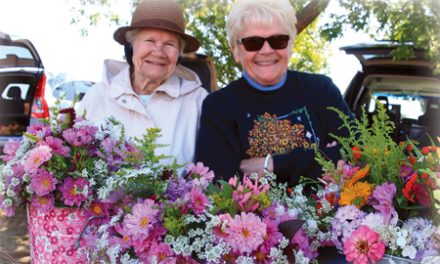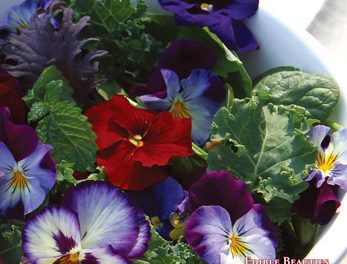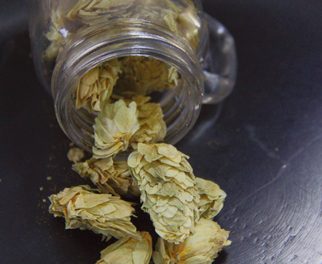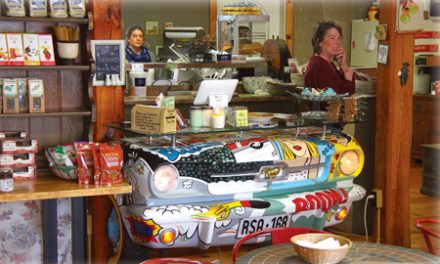By Lisa Whalen.
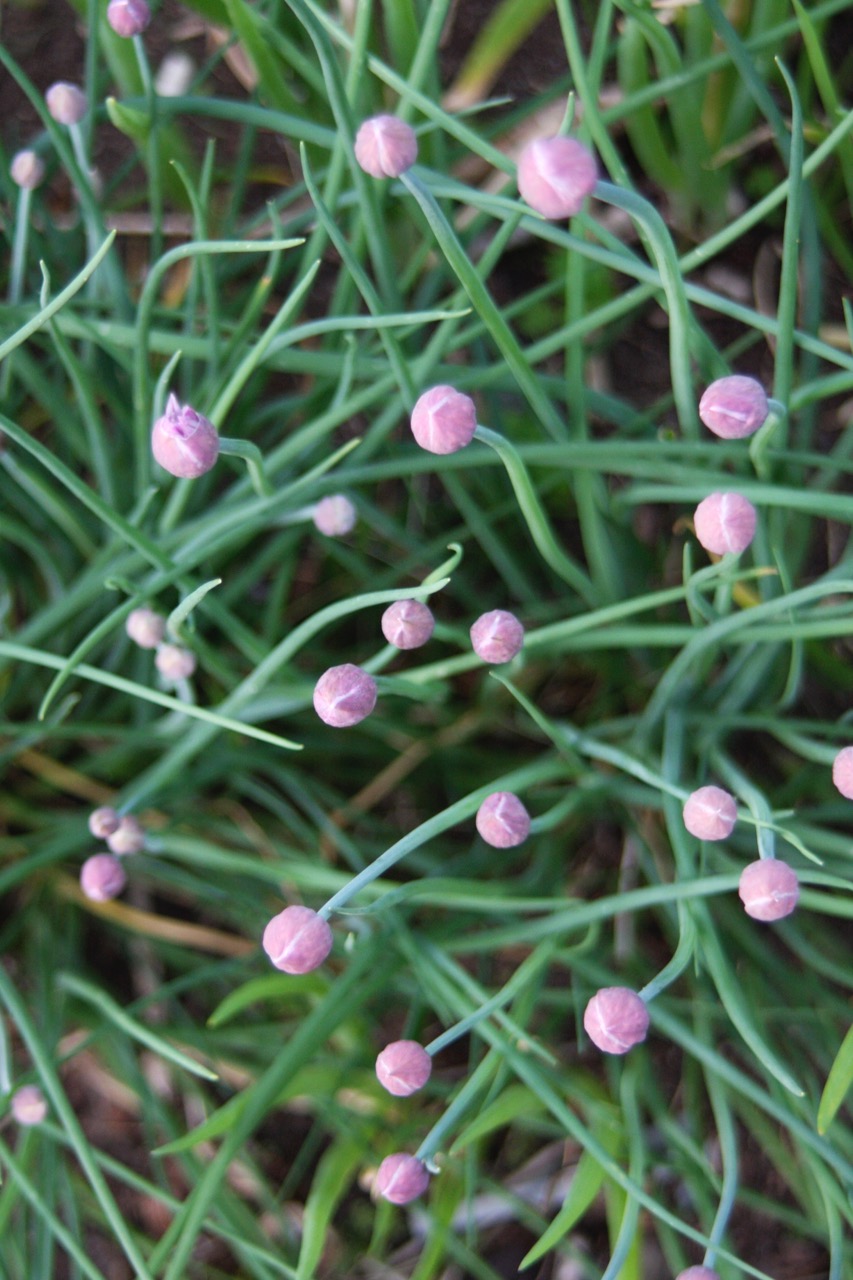
Keep an eye on your chive plants. Harvest the blossoms as soon as they fully bloom. Add to salads or use as a colorful garnish for almost any spring dish
American cooking is clearly the beneficiary of wide-ranging global traditions, many of which include flowers (think chive blossoms, dried daylilies in Chinese hot and sour soup, creamy rose-scented Indian desserts, or Italian ricotta-stuffed squash blossoms). Historically, both the Pilgrims and the native Wampanoag ate buds and blooms. Yet the practice of petal consumption has not exactly been in the American mainstream for several generations, if ever. The 1975 edition of Joy of Cooking observes, “There is a chichi revival of the age-old custom of eating flowers,” an apparently short-lived renaissance as both the comment and the accompanying instructions for “Blooms in Batter” are absent from the next edition.
Botanically speaking, we do regularly eat flowers: broccoli and artichokes are perfect examples. And your cupboard likely includes herbal teas containing chamomile or hibiscus. But that’s not really what we mean here, is it? We’re talking about brilliant blossoms primarily valued for their beauty and fragrance. Daylilies and nasturtiums, violets and calendula, lilacs and roses, to name just a few that happen to be delicious…not to mention all of the flowers produced by plants we already grow for culinary use such as chives and squash. Here, however, the want of a custom for consuming the blooms is somewhat more understandable–by the time most herbs have flowered, their desirable leaves are past their prime.
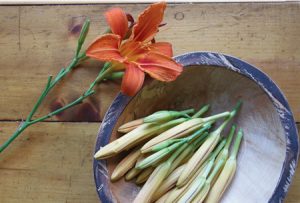
For most fruits and vegetables, the flower precedes the fruit, so you can only harvest one or the other but not both. (Although there’s no tastier way to control a groan-worthy overabundance of homegrown zucchini than to gather blossoms for stuffing and frying.)
You needn’t go further than your own backyard to search out floral edibles. The ubiquitous daylily, the aromatic rose, and the delicate lilac can all be eaten, as can common flowerbed annuals like nasturtium and pansy. Even “weeds” can be served up. Take the pesky dandelion, whose sweet buds and young blooms offer a hint of honey. But before you start nibbling, there are a few things to keep in mind. Most importantly, be certain you know what the plant is, as common names can be confusing. Daylily (Hemerocallis) and Garden Pea (Pisum sativum) blossoms are safe for supper, but Lily of the Valley (Convallaria majalis) and Sweet Pea (Lathyrus) are not.
 As you would with any produce, be sure your chosen blossoms were tended using pest control practices that won’t jeopardize your health. In general, the younger they are, the more palate-pleasing, so plan to pick when blooms have just opened and directly before you will use them as most don’t hold very well. Usually you’ll want to remove reproductive parts and stem attachments, which can be bitter. In other words, keep only the petals. Try a few before you go all in. Varieties and even different colors of the same flower can yield different flavors (and some just aren’t very good at all!). And lastly, ingest in moderation until you know how this new fare sits with you. Many, including daylily and rose, can have a laxative effect.
As you would with any produce, be sure your chosen blossoms were tended using pest control practices that won’t jeopardize your health. In general, the younger they are, the more palate-pleasing, so plan to pick when blooms have just opened and directly before you will use them as most don’t hold very well. Usually you’ll want to remove reproductive parts and stem attachments, which can be bitter. In other words, keep only the petals. Try a few before you go all in. Varieties and even different colors of the same flower can yield different flavors (and some just aren’t very good at all!). And lastly, ingest in moderation until you know how this new fare sits with you. Many, including daylily and rose, can have a laxative effect.
Garnish is probably the simplest way to begin experimenting with flowers in your food. Blossoms can decorate just about any dish, including beverages. Embellish a frosted cake with petal confetti or a cascade of showy daylilies, or freeze tiny star-shaped borage flowers in ice cubes. For a not-so-simple edible adornment that harkens back to earlier times, try candying. Although it’s a somewhat fussy process, it is not difficult to do and the result is thoroughly magical. The single flowers of Johnny-Jump-Up, borage, strawberry, and apple all work nicely here. Paint the petals with beaten egg white, dust them with sugar, then allow them to dry completely. The sugared blossoms are perfect on special occasion cakes, fruit sorbets, or nearly any other dessert. Candied violets are nibbled like M&Ms in England and Europe, but for that kind of casual snacking I’d choose the commercially available rather than the labor-intensive homemade.
Salads are also an easy and pretty place to incorporate blooms, both in the bowl and in the dressing, the latter fashioned with infused oil or vinegar. Fresh daylilies are reminiscent of sweet lettuce; calendula and nasturtium petals add a peppery bite; blue borage flowers suggest cucumber; and chive blossoms taste of onion. Rosemary, lavender, and dill flowers all make flavorful vinegars– another simple DIY. Put your clean, dry flower buds–you might even mix a complementary combination–in a non-reactive jar with a lid. Cover with white wine or champagne vinegar; these light-colored vinegars will take on the tint of the blooms. Cover and set aside to steep for up to two weeks, shaking occasionally. Depending on the proportion of petals to vinegar and the potency of said petals, your vinegar can be ready for tasting in a couple of days. Once you’ve achieved your desired piquancy, strain out the flowers, cover the vinegar and store in a dark cupboard…or better yet, splash generously over grilled meat and fresh greens.
As is so often the case once something is top of mind, examples seemed to pop up everywhere…and so it was as I mulled ideas about cooking and consuming flowers. At a Christmas cookie party, I sampled a delectable butter shortbread speckled with saffron-like dried calendula petals. In the garden supply store, I came across a colorful flower seed mix called Edible Beauties by Botanical Interests®. I found recipes for an array of butters, fritters, cakes and jewel-toned jellies using a
variety of blooms from the everyday to the exotic. The beginnings of another “chichi revival?” I surely can’t say, but I do know that roasted daylily buds and dandelion tempura are on my summer menu.
Want to try a floral meal for yourself? We highly recommend making the Squash Blossom Fritters here or the Hot & Sour Soup here!
When Lisa Whalen was a child, a trip to Grandma’s often included backyard dandelion gathering for the dinner salad. Since then she has discovered that candied violets truly are enchanting and too much rose syrup is indeed purgative!


